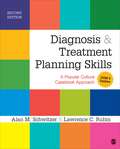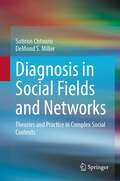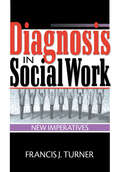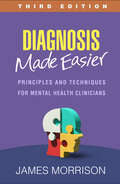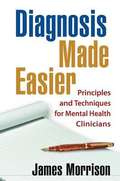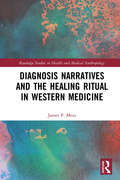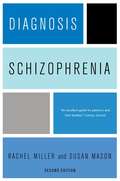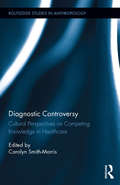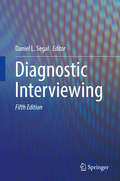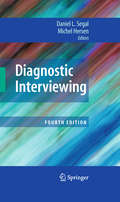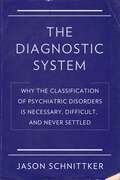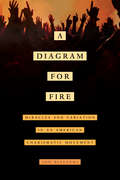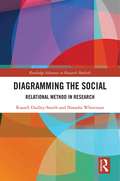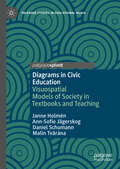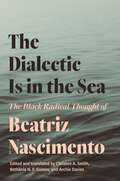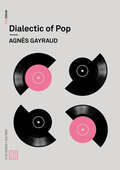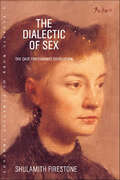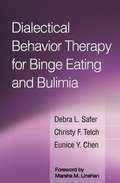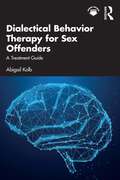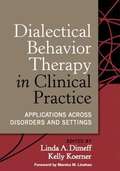- Table View
- List View
Diagnosis and Treatment Planning Skills: A Popular Culture Casebook Approach (2nd Edition) (DSM-5 Update)
by Alan M. Schwitzer Lawrence C. RubinThe Second Edition of Alan M. Schwitzer and Lawrence C. Rubin's Diagnosis and Treatment Planning Skills: A Popular Culture Casebook Approach comprehensively addresses the clinical thinking skills required in professional counseling settings through the innovative use of case examples drawn from popular culture. Fully revised to include DSM-5, the text begins with discussion of diagnosis, case conceptualization, and treatment planning, covering the interplay of individual clinical tools and their application in contemporary practice. Ten DSM-5 updated case illustrations follow, creating a streamlined new edition that engages students in a start-to-finish application of clinical tools.
Diagnosis in Social Fields and Networks: Theories and Practice in Complex Social Contexts
by Sotirios Chtouris DeMond S. MillerContaining a novel compilation of theoretical and methodological approaches, this textbook lays out the most relevant foundations of clinical sociology. Relying heavily on well-recognized medical models and concepts to help communicate ideas (e.g. treatment, diagnosis, clinical, cure), the methods of social diagnosis and social therapy presented in this book will help in better and socially informed protection of vulnerable individuals and citizens as well as an informed design of protection policies for macro, meso and micro levels of society. The book explains that many problems, perceived as economic, psychological-individual, and political, are rooted in social functions and structures of the wider society, and how these social structures and functions interact in everyday life. Through the application of the theoretical and methodological approaches in case studies on recent issues, such as the Covid pandemic, or the Hurricane Katrina disaster, the book will allow readers to easily cope with the complexity of clinical sociology and to develop clinical competencies and pertinent training. This renders the book not only highly useful for advanced undergraduate and graduate students of clinical and applied sociology but also for the preparation of courses for theoretically informed practitioners who are keen to work by defining learning objectives and learning paths.
Diagnosis in Social Work: New Imperatives
by Francis J TurnerHow can you make necessary professional judgments without being judgmental?Assessment and diagnostic skills are essential professional tools for the social worker, but all too often they are neglected or downplayed. Diagnosis in Social Work argues for the reinstatement of social diagnosis to its former place as an essential concept in social work. This courageous book demonstrates the detrimental impact of the loss of diagnostic skills on the quality of social work intervention.Combining meticulous history with insightful analysis, Diagnosis in Social Work shows how the concept of diagnosis in social work has been misunderstood. It examines the negative, narrow definition of diagnosis offered in commonly used texts. Diagnosis in Social Work includes the tools you need to use the power of correct, careful diagnosis, including: case examples of social work diagnoses a thorough profile of the judgments constituting a social work diagnosis suggestions to enhance diagnostic acumen an analysis of diagnosis as a process and a fact ways to use computers in diagnosis an assessment of the risks of diagnosisDiagnosis in Social Work includes everything social work practitioners need to know about the process and meaning of this sorely neglected part of the field. It is an ideal textbook as well, and it offers suggestions for further research.
Diagnosis Made Easier: Principles and Techniques for Mental Health Clinicians
by James MorrisonThe third edition of this incisive practitioner resource and course text--updated for the DSM-5 Text Revision (DSM-5-TR)--takes the reader step by step through diagnostic decision making in mental health. Guidelines are presented for evaluating information from multiple sources, constructing a wide-ranging differential diagnosis, creating a safety hierarchy, and using decision trees to derive a valid working diagnosis. The book addresses specific issues in diagnosing the conditions most often seen in mental health practice, with an emphasis on how diagnosis informs effective treatment. More than 100 vivid vignettes illustrate the diagnostic process and allow readers to practice their skills. New to This Edition *Revised throughout for DSM-5-TR, including the new diagnosis of prolonged grief disorder. *Chapter on eating and sleeping disorders, including new decision trees. *New and updated vignettes and suggested readings.
Diagnosis Made Easier
by James Morrison Richard BalonThis authoritative, user-friendly book offers a complete introduction to the art and science of mental health diagnosis. Meeting a key need for students and novice clinicians, James Morrison, the author of the bestselling DSM-IV Made Easy, systematically takes the reader through every step of the process. He provides clear-cut principles and decision trees for evaluating information from a variety of sources and for constructing a valid working diagnosis that serves as a foundation for treatment. Special features include quick-reference tables, sidebars explaining key concepts, and over 100 case examples that bring the approach to life.
Diagnosis Made Easier, Second Edition: Principles and Techniques for Mental Health Clinicians
by James MorrisonThis popular practitioner guide and course text takes the reader step by step through diagnostic decision making in mental health. Acclaimed for both the clarity of his writing and his clinical expertise, James Morrison provides principles and decision trees for evaluating information from multiple sources and constructing a valid, clinically useful working diagnosis. More than 100 vivid vignettes--from the straightforward to the toughest cases--illustrate the practical application of these methods. Essential topics include developing a differential diagnosis, dealing with comorbidity; and determining when physical illness may be the cause of mental health symptoms. New to This Edition *Revised throughout for DSM-5. *Updated resources and suggested readings.
Diagnosis Narratives and the Healing Ritual in Western Medicine (Routledge Studies in Health and Medical Anthropology)
by James Peter MezaThe dominance of "illness narratives" in narrative healing studies has tended to mean that the focus centers around the healing of the individual. Meza proposes that this emphasis is misplaced and the true focus of cultural healing should lie in managing the disruption of disease and death (cultural or biological) to the individual’s relationship with society. By explicating narrative theory through the lens of cognitive anthropology, Meza reframes the epistemology of narrative and healing, moving it from relativism to a philosophical perspective of pragmatic realism. Using a novel combination of narrative theory and cognitive anthropology to represent the ethnographic data, Meza’s ethnography is a valuable contribution in a field where ethnographic records related to medical clinical encounters are scarce. The book will be of interest to scholars of medical anthropology and those interested in narrative history and narrative medicine.
Diagnosis Schizophrenia
by Miller Rachel Mason Susan E.In this book, thirty-five young, recently diagnosed patients speak about schizophrenia and the process of recovery, while two specialists illuminate the medical science, psychoeducation, and therapeutic needs of those coping with the illness, as well as access to medical benefits and community resources. A remarkably inclusive guide, the volume informs patients, families, friends, and professionals, detailing the possible causes of schizophrenia, medications and side effects, the functioning of the brain, and the value of rehabilitation and other services. In their dialogues, participants confront shame, stigma, substance use, and relapse issues and the necessity of healthy eating, safe sex practices, and coping skills during recovery. Clinicians elaborate on the symptoms of schizophrenia, such as violent and suicidal thoughts, delusions, hallucinations, memory and concentration problems, trouble getting motivated or organized, and anxiety and mood disorders. Adopting an uplifting tone of manageability, the participants, authors, and clinicians of this volume offer more than advice& mdash;they prescribe hope.
Diagnostic and Behavioral Assessment in Children and Adolescents
by Bryce D. Mcleod Amanda Jensen-Doss Thomas H. OllendickThis comprehensive volume shows how to use both diagnostic and behavioral assessment knowledgeably and effectively throughout the process of treatment. The two traditions have developed along separate paths--each with its own conceptual underpinnings and psychometric strengths. Used together, they can produce a complete picture of a child's or adolescent's needs and strengths. The expert editors and contributors describe the full range of evidence-based assessment tools and illustrate their application with two intake-to-termination case examples, both based on DSM-5. Reproducible tools include a behavioral recording form and a multipage case conceptualization worksheet that can be downloaded and printed in a convenient 8 1/2" x 11" size.
Diagnostic Controversy: Cultural Perspectives on Competing Knowledge in Healthcare (Routledge Studies in Anthropology #25)
by Carolyn Smith-MorrisThis collection is dedicated to the diagnostic moment and its unrivaled influence on encompassment and exclusion in health care. Diagnosis is seen as both an expression and a vehicle of biomedical hegemony, yet it is also a necessary and speculative tool for the identification of and response to suffering in any healing system. Social scientific studies of medicalization and the production of medical knowledge have revealed tremendous controversy within, and factitiousness at the outer parameters of, diagnosable conditions. Yet the ethnographically rich and theoretically complex history of such studies has not yet congealed into a coherent structural critique of the process and broader implications of diagnosis. This volume meets that challenge, directing attention to three distinctive realms of diagnostic conflict: in the role of diagnosis to grant access to care, in processes of medicalization and resistance, and in the transforming and transformative position of diagnosis for 21st-century global health. Smith-Morris’s framework repositions diagnosis as central to critical global health inquiry. The collected authors question specific diagnoses (e.g., Lyme disease, Parkinson's, andropause, psychosis) as well as the structural and epistemological factors behind a disease’s naming and experience.
Diagnostic Interviewing
by Daniel L. SegalThis volume represents a clear, jargon-free overview of diagnostic categories with helpful hints regarding a psychiatric interview. Completely revised and updated, detailing current innovations in theory and practice, including recent changes in the DSM-IV.
Diagnostic Interviewing
by Daniel L. Segal Michel HersenThis volume represents a clear, jargon-free overview of diagnostic categories with helpful hints regarding a psychiatric interview. Completely revised and updated, detailing current innovations in theory and practice, including recent changes in the DSM-IV.
The Diagnostic System: Why the Classification of Psychiatric Disorders Is Necessary, Difficult, and Never Settled
by Jason SchnittkerMental illness is many things at once: It is a natural phenomenon that is also shaped by society and culture. It is biological but also behavioral and social. Mental illness is a problem of both the brain and the mind, and this ambiguity presents a challenge for those who seek to accurately classify psychiatric disorders. The leading resource we have for doing so is the American Psychiatric Association’s Diagnostic and Statistical Manual, but no edition of the manual has provided a decisive solution, and all have created controversy. In The Diagnostic System, the sociologist Jason Schnittker looks at the multiple actors involved in crafting the DSM and the many interests that the manual hopes to serve. Is the DSM the best tool for defining mental illness? Can we insure against a misleading approach?Schnittker shows that the classification of psychiatric disorders is best understood within the context of a system that involves diverse parties with differing interests. The public wants a better understanding of personal suffering. Mental-health professionals seek reliable and treatable diagnostic categories. Scientists want definitions that correspond as closely as possible to nature. And all parties seek definitive insight into what they regard as the right target. Yet even the best classification system cannot satisfy all of these interests simultaneously. Progress toward an ideal is difficult, and revisions to diagnostic criteria often serve the interests of one group at the expense of another. Schnittker urges us to become comfortable with the socially constructed nature of categorization and accept that a perfect taxonomy of mental-health disorders will remain elusive. Decision making based on evolving though fluid understandings is not a weakness but an adaptive strength of the mental-health profession, even if it is not a solid foundation for scientific discovery or a reassuring framework for patients.
Diagnostik im Strafvollzug: Eine praxisorientierte Einführung (Basiswissen Soziale Arbeit #7)
by Stefanie Schmidt Silvia Sibyll HawliczekDas Lehrbuch ist eine praxisnahe Einführung in das Arbeitsfeld und die methodischen Herangehensweisen der Diagnostik im Strafvollzug. Es richtet sich zuvorderst an Psychologinnen und Psychologen sowie Sozialarbeiterinnen und Sozialarbeiter, die im Rahmen ihrer Tätigkeit im Justizvollzug mit diagnostischen Einschätzungen betraut sind sowie Studierende dieser Fächer. Nach einer Einführung in die Aufgaben und Rahmenbedingungen, die Diagnostik im Strafvollzug berühren, werden zwei verschiedene Modelle zur Rehabilitation straffälliger Personen (Risk-Need-Responsivity und Good Lives Model) vorgestellt, die der Diagnostik im Strafvollzug einen theoretischen Rahmen geben. Daran anknüpfend führt das Lehrbuch in unterschiedliche Methoden ein, welche den diagnostischen Urteilsprozess strukturieren. Diese Grundlagen münden schließlich in ein stärker praxisorientiertes Kapitel, in dem der Prozess der Urteilsbildung anhand zahlreicher Beispiele schrittweise vorgestellt wird.
A Diagram for Fire: Miracles and Variation in an American Charismatic Movement
by Jon BialeckiWhat is the work that miracles do in American Charismatic Evangelicalism? How can miracles be unanticipated and yet worked for? And finally, what do miracles tell us about other kinds of Christianity and even the category of religion? A Diagram for Fire engages with these questions in a detailed sociocultural ethnographic study of the Vineyard, an American Evangelical movement that originated in Southern California. The Vineyard is known worldwide for its intense musical forms of worship and for advocating the belief that all Christians can perform biblical-style miracles. Examining the miracle as both a strength and a challenge to institutional cohesion and human planning, this book situates the miracle as a fundamentally social means of producing change—surprise and the unexpected used to reimagine and reconfigure the will. Jon Bialecki shows how this configuration of the miraculous shapes typical Pentecostal and Charismatic religious practices as well as music, reading, economic choices, and conservative and progressive political imaginaries.
Diagramming the Social: Relational Method in Research (Routledge Advances in Research Methods)
by Russell Dudley-Smith Natasha WhitemanThis book challenges the hyper-production and proliferation of concepts in modern social research. It presents a distinctive methodological response to this tendency through an exploration of one of the most underappreciated yet widely deployed conventions for the analysis of social processes: the creation of diagrammatic relational spaces. Designed to capture social processes in a way that resists reductive and essentialist categories, such spaces have the capacity to produce powerful, systematic analyses that break the spell of concept proliferation and its resultant naively realist approach to explaining the world. Through an exploration of key examples and series of original case studies, the authors demonstrate the application of this approach across a variety of empirical settings and academic disciplines. They thus offer a relational and pragmatic approach to social research that resists current trends characterised by supposedly self-evident data and/or disconnected theory. As such, the book constitutes an important contribution to some of the central questions in current social research, and promises to unsettle and reinvigorate considerations of method across different fields of practice.
Diagrams in Civic Education: Visuospatial Models of Society in Textbooks and Teaching (Palgrave Studies in Educational Media)
by Janne Holmén Ann-Sofie Jägerskog Daniel Schumann Malin TvärånaThis book presents the findings of three studies on the use of diagrams in civic education. The first study presents an international comparison of textbook diagrams promoting national unity in diversity, with examples from ten countries. The second focuses on the depiction of migration in diagrammatic form in German textbooks, The final study was conducted in collaboration with teachers in Swedish social science classrooms, and focuses on teaching comprehension of flow charts and scatterplots. The book will be of interest to scholars of educational media, didactics, the history of education and citizenship education.
The Dialectic Is in the Sea: The Black Radical Thought of Beatriz Nascimento
by Beatriz NascimentoCollected writings by one of the most influential Black Brazilian intellectuals of the twentieth centuryBeatriz Nascimento (1942–1995) was a poet, historian, artist, and political leader in Brazil&’s Black movement, an innovative and creative thinker whose work offers a radical reimagining of gender, space, politics, and spirituality around the Atlantic and across the Black diaspora. Her powerful voice still resonates today, reflecting a deep commitment to political organizing, revisionist historiography, and the lived experience of Black women. The Dialectic Is in the Sea is the first English-language collection of writings by this vitally important figure in the global tradition of Black radical thought.The Dialectic Is in the Sea traces the development of Nascimento&’s thought across the decades of her activism and writing, covering topics such as the Black woman, race and Brazilian society, Black freedom, and Black aesthetics and spirituality. Incisive introductory and analytical essays provide key insights into the political and historical context of Nascimento&’s work. This engaging collection includes an essay by Bethânia Gomes, Nascimento&’s only daughter, who shares illuminating and uniquely personal insights into her mother&’s life and career.
Dialectic of Pop (Urbanomic: Mono #8)
by Agnes GayraudA philosophical exploration of pop music that reveals a rich, self-reflexive art form with unsuspected depths. In the first major philosophical treatise on the subject, Agnès Gayraud explores all the paradoxes of pop—its inauthentic authenticity, its mass production of emotion and personal resonance, its repetitive novelty, its precision engineering of seduction—and calls for pop (in its broadest sense, encompassing all genres of popular recorded music) to be recognized as a modern, technologically mediated art form to rank alongside cinema and photography. In a thoroughgoing engagement with Adorno's fierce critique of "standardized light popular music," Dialectic of Pop tracks the transformations of the pop form and its audience over the course of the twentieth century, from Hillbilly to Beyoncé, from Lead Belly to Drake. Inseparable from the materiality of its technical media, indifferent and intractable to the perspectives of high culture, pop subverts notions of authenticity and inauthenticity, original and copy, aura and commodity, medium and message. Gayraud demonstrates that, far from being the artless and trivial mass-produced pabulum denigrated by Adorno, pop is a rich, self-reflexive artform that recognises its own contradictions, incorporates its own productive negativity, and often flourishes by thinking "against itself."Dialectic of Pop sings the praises of pop as a constitutively impure form resulting from the encounter between industrial production and the human predilection for song, and diagnoses the prospects for twenty-first century pop as it continues to adapt to ever-changing technological mediations.
The Dialectic of Sex: The Case for Feminist Revolution
by Shulamith Firestone“No one can understand how feminism has evolved without reading this radical, inflammatory second-wave landmark.” —Naomi WolfOriginally published in 1970, when Shulamith Firestone was just twenty-five years old, and going on to become a bestseller, The Dialectic of Sex was the first book of the women's liberation movement to put forth a feminist theory of politics.Beginning with a look at the radical and grassroots history of the first wave (with its foundation in the abolition movement of the time), Firestone documents its major victory, the granting of the vote to women in 1920, and the fifty years of ridicule that followed. She goes on to deftly synthesize the work of Freud, Marx, de Beauvoir, and Engels to create a cogent argument for feminist revolution. Identifying women as a caste, she declares that they must seize the means of reproduction—for as long as women (and only women) are required to bear and rear children, they will be singled out as inferior. Ultimately she presents feminism as the key radical ideology, the missing link between Marx and Freud, uniting their visions of the political and the personal.In the wake of recent headlines bemoaning women's squandered fertility and the ongoing debate over the appropriate role of genetics in the future of humanity, The Dialectic of Sex is revealed as remarkably relevant to today's society—a testament to Shulamith Firestone's startlingly prescient vision. Firestone died in 2012, but her ideas live on through this extraordinary book.“A must-have for those interested in feminist theory, both past and present.” ―Kathleen Hanna, founding member of the Riot Grrrls movement
The Dialectic Of Sex: The Case For Feminist Revolution
by Shulamith FirestoneA best-seller upon its original publication in 1970--when Shulamith Firestone was just twenty-five years old--The Dialectic of Sex was the first book of the women's liberation movement to put forth a feminist theory of politics. Beginning with a look at the radical grassroots history of the first wave of feminism and its foundation in the abolition movement, Firestone documents its major victory, the granting of the vote to women in 1920, and the fifty-year backlash that followed. Deftly synthesizing the work of Freud, Marx, de Beauvoir, and Engels, Firestone creates a powerful argument for feminist revolution in which she asserts that women must seize the means of reproduction. For as long as women (and only women) are required to bear and rear children, they will lack the biological and attendant economic independence required to be completely liberated. Ultimately, she presents feminism as the key radical ideology, the missing link between Marx and Freud, uniting their visions of the political and the personal. As revelatory and urgent as it was upon its first publication, The Dialectic of Sex is a testament to Shulamith Firestone's startlingly prescient vision. It remains required reading for anyone concerned about the history of feminism as well as the ongoing hurdles faced by women to this day in regard to motherhood, child care, and career.
Dialectical Behavior Therapy for Binge Eating and Bulimia
by MD Debra L. Safer Marsha M. Linehan PhD Christy F. Telch PhD Eunice Y. ChenThis groundbreaking book gives clinicians a new set of tools for helping people overcome binge-eating disorder and bulimia. It presents an adaptation of dialectical behavior therapy (DBT) developed expressly for this population. The treatment is unique in approaching disordered eating as a problem of emotional dysregulation. Featuring vivid case examples and 32 reproducible handouts and forms, the book shows how to put an end to binge eating and purging by teaching clients more adaptive ways to manage painful emotions. Step-by-step guidelines are provided for implementing DBT skills training in mindfulness, emotion regulation, and distress tolerance, including a specially tailored skill, mindful eating. Purchasers get access to a Web page where they can download and print the reproducible handouts and forms in a convenient 8 1/2" x 11" size.
Dialectical Behavior Therapy for Binge Eating and Bulimia
by Christy Telch Debra SaferThis groundbreaking book gives clinicians a new set of tools for helping people overcome binge-eating disorder and bulimia. It presents an adaptation of dialectical behavior therapy (DBT) developed expressly for this population. The treatment is unique in approaching disordered eating as a problem of emotional dysregulation. Featuring vivid case examples and 32 reproducibles, the book shows how to put an end to binge eating and purging by teaching clients more adaptive ways to manage painful emotions. Step-by-step guidelines are provided for implementing DBT skills training in mindfulness, emotion regulation, and distress tolerance, including a specially tailored skill, mindful eating.
Dialectical Behavior Therapy for Sex Offenders: A Treatment Guide
by Abigail KolbThis treatment guide allows clinicians to effectively integrate dialectical behavior therapy (DBT) as a psychological treatment with men who have committed sexually motivated offenses.It provides clinicians with the most current, evidence-based research about sex offenders' risks and treatment needs, and draws upon the therapeutic techniques of DBT and cognitive behavioural therapy. This guide is divided into five parts that provide practical, evidence-based skills for clients to apply to their lives and reduce their likelihood of recidivism. It explores numerous skill sets that target all major areas of dysregulation commonly seen among men who have committed sexual offences. Worksheets, images, group discussion ideas, and role-play scenarios are used throughout to help clients practice their skills within the group setting and on their own.This guide is essential for all mental health professionals who work with men who have committed sexual crimes.
Dialectical Behavior Therapy in Clinical Practice
by Linda Dimeff Kelly KoernerFirst developed to treat suicidal individuals with borderline personality disorder, dialectical behavior therapy (DBT) has since been adapted to a range of settings and populations. This practical book--edited by close collaborators of DBT originator Marsha M. Linehan--presents applications for depression, substance dependence, eating disorders, psychosis, suicidal and assaultive behaviors, and other complex problems. Leading contributors, including Linehan herself, describe how to implement this evidence-based treatment with adults, adolescents, couples and families, and forensic clients. Issues in establishing and maintaining an effective DBT program are also addressed. Special features include over a dozen reproducible worksheets and forms, which book buyers can also download and print from Guilford's website.
